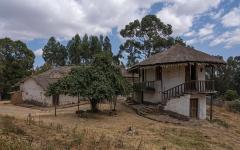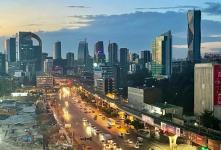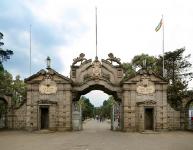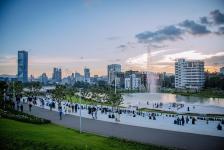
In this VFR - GPS Flight Plan we take off from the airport of Lalibella (HALL), fly to the south, overfly the Entoto mountain, the city of Addos Ababa, the Suba Meganesha park and finally land in the airport of Harar Meda (HAHM)
At the bottom of this page you will find the download link of this Flight Plan (.PLN file)

In this VFR - GPS Flight Plan we take off from
the airport of Lalibella (HALL), fly to the south, overfly the Entoto
mountain, the city of Addos Ababa, the Suba Meganesha park and finally
land in the airport of Harar Meda (HAHM)
Find below a short extract and screenshots of the main points of the route. In this journey around Africa I have used the Cessna 172S (Skyhawk)

Take off from the runway 28 of the airport of Lalibella (HALL).
Lalibela Airport (IATA: LLI, ICAO: HALL) is an airport serving Lalibela, a town in the Amhara Region of Ethiopia. The name of the town and airport may also be transliterated as Lalibella.
The airport is located 23 km (14 miles) southwest of the town. (*1)

This route crosses several mountains higher that 10,000
feet so we ascent to 12.000 feet.

Overflying the highest point of the route, nearly 12,000
feet high.

Passing over Debre Tsige.
Debre Tsige is next to Dirē and is located in Oromiya Region, Ethiopia

Approaching Mount Entoto
the city of Addis Ababa becomes visible.
Mount Entoto is the highest peak on the Entoto Mountains, which overlooks the city of Addis Ababa, the capital of Ethiopia. It reaches 3,200 meters above sea level.
It is a historical place where Emperor Menelik II resided and built his palace, when he came from Ankober and founded Addis Ababa. It is considered a sacred mountain and has many monasteries. Mount Entoto is also the location of a number of celebrated churches, including Saint Raguel and Saint Mary.
The mountain is densely covered by eucalyptus trees that were imported from Australia during the reign of Menelik II, and mostly planted during Emperor Haile Selassie's reign. Thus, it is sometimes referred to as the "lung of Addis Ababa". The forest on the mountain is an important source of firewood for the city. It was also a source of building material in earlier times.
The Ethiopian Heritage Trust, a non-profit, non-governmental organization, is working actively to change part of the mountain to its old state, a natural park. Entoto Natural Park is the northeastern rim of Addis Abeba, on the southeastern slopes of Mt. Entoto, covering an area of 1,300 hectares. It is situated at an altitude of between 2,600 and 3,100 meters. Its annual average rainfall and temperature are 1200 mm and 14°C, respectively. The northern rim of the park serves as a watershed between the Abay (Blue Nile) and Awash rivers.
The Ethiopian Space Science Society has an observatory on the 3,200 m summit. (*1)
 |
 |
|
| Maryam (St Mary) Church By A.Savin |
Emperor's
palace By A.Savin |

Reaching Addis Ababa.
Addis Ababa, lit. "new flower"; also known as Finfinne, lit. "natural spring" in Oromo, is the capital and largest city of Ethiopia. It is also serves as the capital of the Oromia Region. In the 2007 census, the city's population was estimated to be 2,739,551 inhabitants. Addis Ababa is a highly developed and important cultural, artistic, financial and administrative centre of Ethiopia.
Addis Ababa was portrayed in the 15th century as a fortified location called "Barara" that housed the emperors of Ethiopia at the time. Prior to Emperor Dawit II, Barara was completely destroyed during the Ethiopian–Adal War and Oromo expansions. The founding history of Addis Ababa dates back in late 19th-century by Menelik II, Negus of Shewa, in 1886 after finding Mount Entoto unpleasant two years prior.[ At the time, the city was a resort town; its large mineral spring abundance attracted nobilities of the empire, led them to establish permanent settlement. It also attracted many members of the working classes — including artisans and merchants — and foreign visitors. Menelik II then formed his imperial palace in 1887. Addis Ababa became the empire's capital in 1889, and subsequently international embassies were opened. Addis Ababa urban development began at the beginning of the 20th century, and without any preplanning.
Addis Ababa saw a wide-scale economic boom in 1926 and 1927, and an increase in the number of buildings owned by the middle class, including stone houses filled with imported European furniture. The middle class also imported newly manufactured automobiles and expanded banking institutions. During the Italian occupation, urbanization and modernization steadily increased by a master plan which they hoped Addis Ababa would be more colonial city and continued after their occupation. Consequent master plans were designed by French and British consultants from 1940s onwards focusing on monumental structures, satellite cities and inner-city. Similarly, the Italo-Ethiopian master plan also projected in 1986 concerning only urban structure and accommodating service, which was later adapted by the 2003 master plan.
Addis Ababa remains federal chartered city in accordance with the Addis Ababa City Government Charter Proclamation No. 87/1997 in the FDRE Constitution. Called "the political capital of Africa" due to its historical, diplomatic, and political significance for the continent, Addis Ababa serves as the headquarters of major international organizations such as the African Union and the United Nations Economic Commission for Africa.
The city lies a few kilometres west of the East African Rift, which splits Ethiopia into two, between the Nubian Plate and the Somali Plate. The city is surrounded by the Special Zone of Oromia and is populated by people from the different regions of Ethiopia. It is home to Addis Ababa University. The city has a high human development index and is known for its vibrant culture, strong fashion scene, high involvement of young people, thriving arts scene, and for having the fastest economic growth of any country in the world. (*1)
 |
 |
 |
| Meskel Square project and
Skyline of Addis Ababa, 2021 By ምቅ37382- CC BY-SA 4.0 |
Addis Ababa University By Sailko. - CC BY 3.0 |
Partial view of Addis Ababa
skyline from Sheger park By DaneyWiki - CC BY-SA 4.0 |

Another view of Addis Ababa.

Leaving Addis Ababa we fly near Wochecha mountain.
Wochecha Mountain (3,391m / 11,125ft a.s.l.) is a mountain in the Entoto Mountains in Ethiopia.

The Suba Menagesha national forest.
From there we fly straight to the airport of Harar Meda (HAHM), not far away at the south east of Addis Ababa, and land in the runway 16. This airport is the main base for the Ethiopian Air Force and landing there is one of the advantages of using a flight simulator :-)
You can download for free this Flight Plan but only for your own private use. It is strictly forbidden to share it or publish it in other sites, forums, newsgroups or in any other way . You are encouraged to share and publish links to this page only, but not direct links to the file itself.
(*1) Credits: The descriptive texts are mainly an excerpt of those provided by Wikipedia. Visit Wikipedia to read the full descriptions.
See other MS Flight Simulator flight plans and instructions
Disclaimer: These instructions and flight plan are intended to be used only for MS Flight Simulator and should not be used for real flights.